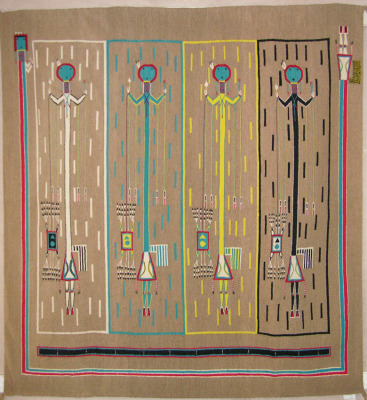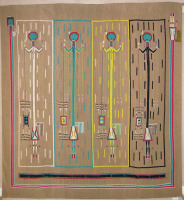The Water Sprinklers by Gladys Manuelito
This Navajo rug measures 63" x 67", hand-spun yarn, natural white and brown, all other colors are aniline dyed, excellent condition, c. late 1930's, woven by Gladys Manuelito, "Mrs.Sam."
This textile is a piece of history. It is a Navajo treasure, an American treasure and a piece of aboriginal mythology. Gladys Manuelito was the niece of Navajo Medicine Man, Hasteen Klah and wove the Sand-painting images he gave her.
Klah was the first Medicine Man to break the taboo on creating a Sand-painting image in a permanent form. This was brilliance to the Navajo rug buying public and blasphemy to many of the Navajos. The radical break is analogous to Stravinsky's "Rite of Spring" or Bob Dylan's first electric set at the Newport Folk Festival.
"The Water Sprinklers" is part of "The Nightway Chant." This particular version is the only known piece to have the four directional colors (white, turquoise, yellow and black) portrayed in dashes that resemble raindrops. The piece was woven near the end of Klah's life and the assumption is that he had Gladys weave this variation.
For more information on Klah and Gladys, see "Dances With Wool" by Mark Winter.
This textile is a piece of history. It is a Navajo treasure, an American treasure and a piece of aboriginal mythology. Gladys Manuelito was the niece of Navajo Medicine Man, Hasteen Klah and wove the Sand-painting images he gave her.
Klah was the first Medicine Man to break the taboo on creating a Sand-painting image in a permanent form. This was brilliance to the Navajo rug buying public and blasphemy to many of the Navajos. The radical break is analogous to Stravinsky's "Rite of Spring" or Bob Dylan's first electric set at the Newport Folk Festival.
"The Water Sprinklers" is part of "The Nightway Chant." This particular version is the only known piece to have the four directional colors (white, turquoise, yellow and black) portrayed in dashes that resemble raindrops. The piece was woven near the end of Klah's life and the assumption is that he had Gladys weave this variation.
For more information on Klah and Gladys, see "Dances With Wool" by Mark Winter.



